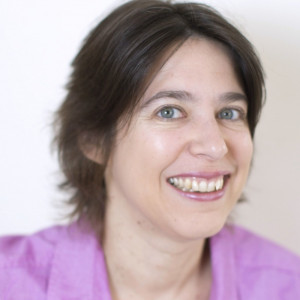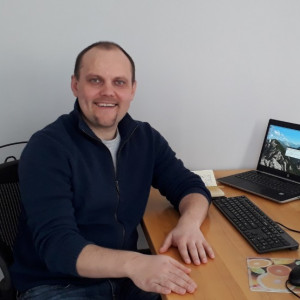What does your workday routine look like?
Interview with Pilar, director of Virtual Not Distant
So, one of the things I do is I work at the coworking space on Saturday mornings when there is no one. Also, I really don't have much of a routine.
The only routine is that I wake up at the same time every day and have breakfast with my husband while watching a sitcom, which lasts about 20 minutes.
We have a long breakfast with coffee, and that is the only routine I have.
Hear about Pilar's flexible approach to managing Virtual Not Distant and the career-changing advice she received from a friend.
Read full interview from Interview with Pilar, director of Virtual Not Distant .
Interview with Deborah, a remote entrepreneur changing perceptions about remote work
The truth is, it varies. When I'm at home, it always starts with fresh coffee and responding to the most urgent emails. I find I get started almost as soon as I wake up, and then I get around to showering and getting dressed at around 10.30, and then continuing with work.
If I'm going to be at home all day and can afford a bit of distraction, then I'll go for a walk or a swim on Hampstead Heath at lunchtime, or go to a cafe for lunch and to work for a couple of hours.
There's a dog pond on Hampstead Heath close to where I live, so sometimes I go there to dog stalk.
It's amazing what a cuddle with a furry friend can do for your day!
Otherwise, I go stir crazy and bounce off the walls (one of the most prevalent challenges for remote / home workers). If I'm traveling and in a different time zone, then it does depend more on my clients' needs. I NEVER have the TV on when I work, but I often listen to music or a podcast.
Deborah has traveled the world sharing her research about the pros of remote work. See how she is helping companies and clients understand the importance of location independence.
Read full interview from Interview with Deborah, a remote entrepreneur changing perceptions about remote work.
Interview with Mehmet, a nomadic digital maker and entrepreneur
I’m an early(ish) riser. I have two 2-year-old kids. They wake up at 6 am sharp. So I stop using alarms. Generally, a short time spent with them follows with dropping them off to daycare then I sit on my desk between 8-8:30 am.
That gives me roughly half an hour before my team stand-up (half of our team is in Europe). We don’t do stand-ups on Fridays, so Fridays are generally very quiet on our communication channels.
I personally work longer hours on Mon-Thu and try to keep Friday as my “thinking” day, where I try to stay away from attending to work-related stuff. I experiment and play with things a lot on Fridays.
As a team, we try to keep Mondays for a planning and week kick-off day, so there are generally few meetings between team members to discuss stuff for the week.
We have a rule not to have any team-wide meetings on Tuesdays and Wednesdays. We call it “quiet” days. People can completely disappear the whole day after stand-up if they want.
Most people are offline these days, and the expected reply time is about 1-2 hours.
Thursdays are generally our big day, where we close a week cycle sprint and plan the next one. So we have sub-team based meetings (separate engineer and design team recap and have meetings to plan the next sprint).
This allows Fridays to be more standalone (everybody can personally digest what’s coming in that sprint and do research, and experimental work). By Monday morning, everybody knows the plan, and we generally have a light kick-off meeting repeating what’s planned for that sprint.
Mehmet has embraced his remote team leadership style. Hear about his most helpful productivity trick and why he has "quiet" days for his staff.
Read full interview from Interview with Mehmet, a nomadic digital maker and entrepreneur .
Interview with Pola, a Paris-based content writer
I check in with the team in the morning, make coffee, and then get on with my projects!
I make sure to take a real lunch break (luckily, France is good for that) to recharge and avoid the afternoon crash.
I also like to take a walk in the evening, because too much time in front of the computer can take a toll on the body. Not having a commute means I can get 7-8 hours of sleep every night, which makes a big difference in terms of productivity and mood.
A job ad in an online group led Pola to find her ideal career as a content writer—see her remote work & job seeking takeaways.
Read full interview from Interview with Pola, a Paris-based content writer.
Interview with Lauren, a content marketing team lead and hybrid remote worker
Funnily enough, I wake up around the same time as I would for a day commuting into the office. I normally walk my dog on WFH days in the morning and then get to work.
I always check my emails and Slack first to see if anything important came up, then I check Asana to see what deadlines I have that day. Throughout the day, I check Slack to ensure I haven’t missed anything.
I check Slack more frequently when I’m WFH than when I’m in the office. When I work in the office, people can come to my desk if they have an important question. Slack, in a way, is my office when I’m WFH. So I make an effort to be more active when I’m remote.
For Lauren, remote work was a non-negotiable arrangement—see how she manages a hybrid remote work situation and her tips for those on the remote job search.
Read full interview from Interview with Lauren, a content marketing team lead and hybrid remote worker.
Interview with Mike, a business developer with a one task a day remote work routine
My workday actually begins while I’m still in bed by checking my emails. After a short breakfast, I reply to emails that require attention and plan activities for the day. At 10 AM each morning, I have a stand-up call with my team, where we share and discuss our daily plans.
Each of us has one task that we focus on each day, as well as a set of smaller tasks. These smaller tasks help us remain productive when we face roadblocks with the main task or when the main task is complete.
Mike had a lackluster experience with remote work 12 years ago. Today, he has embraced location-independence. Hear about his "one task a day" routine & vital tip for job seekers.
Read full interview from Interview with Mike, a business developer with a one task a day remote work routine.





